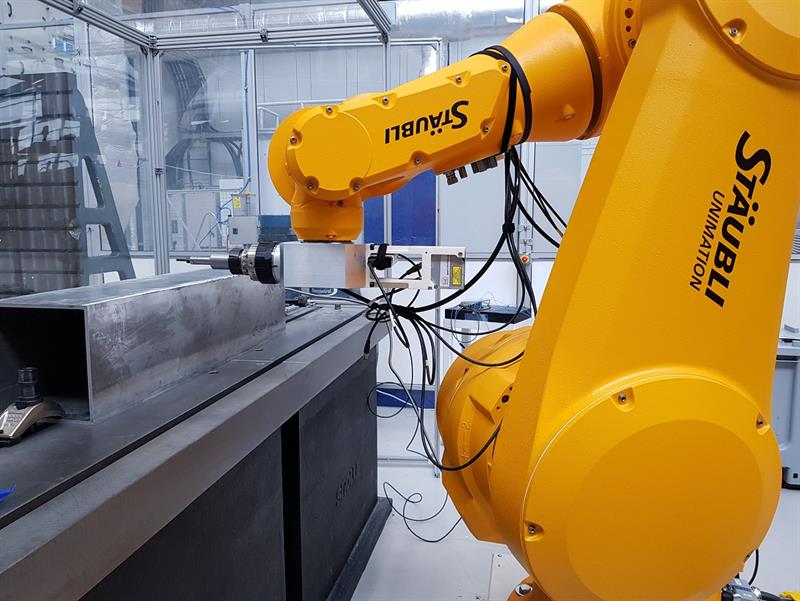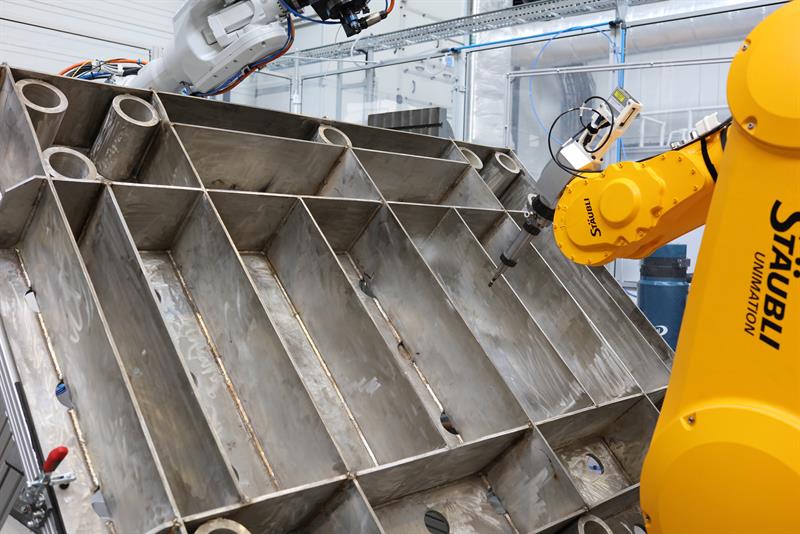Coroma is a robotic system development and integration project to automate a variety of manufacturing tasks. Most of these tasks are secondary finishing operations (e.g. grinding, sanding, deburring, etc.) which are typically carried out manually on welded components such as nuclear fuel racks and tube structures.
As Ozan Gurdal, research engineer at Nuclear AMRC states: “Manual finishing can take tens of hours of cycle time, as well as being a health and safety issue. The idea of the Coroma Project was to use robots to automate these processes with sensor and software assistance and to demonstrate the work on full-scale demonstrators provided by the use case owner companies.”
Nuclear AMRC’s involvement in the project was to develop a smart robotic grinding/deburring solution for welded components. The use case owner was Equipos Nucleares SA, a nuclear fabricator from Spain. Gurdal adds: “We developed an integrated end-effector for the robot with a Micro-Epsilon 2910-100 BL laser profile sensor on one end and a pneumatic spindle on the other – to eliminate the need to use a tool changing system, which would stand out as an expensive item.”
“It is not possible to use the part’s design CAD model when it comes to programming robots for weld grinding or conditioning as there is a significant [sufficient to affect robot paths] difference between the design and actual [as-welded] part because distortion and/or warpage is inevitable after welding and so exact weld sizes are unknown. Therefore, the 3D CAD model of the as-welded part is required to programme paths accurately,” explains Gurdal.

The scanCONTROL 2910-100_BL laser sensor held by the end effector is used to scan the areas of interest in the part, which are welded joints
and planar surfaces used for reference. The sensor provides the axial and lateral distance (2D) measurements between the scanned object and sensor frame, which is not sufficient for reconstruction. Therefore, the 2D data obtained from the laser sensor is combined with the position of the robot flange, which is read in real-time from the robot controller using a LabVIEW-based central controller. Combining these two, the central controller generates the 3D reconstruction of the as-welded part as a point-cloud and converts it into the desired CAD format.
“The 3D CAD model of the as-welded part is then used to generate grinding/deburring paths either offline [using CAM or robot path programming software] or online using in-house developed path generation algorithms. Once path generation has been completed, the grinding or deburring operation begins,” states Gurdal. The robot used for this work was a six-axis Staubli TX200, as Staubli was one of the partners on the project.
The scanCONTROL 2910-100_BL is a compact, high performance laser profile sensor (laser line scanner) with integrated electronics that makes it ideally suited to robot mounting. It operates using blue (violet) laser technology rather than red, especially useful for measuring against shiny metallic structures or difficult-to-measure surfaces. The sensor projects a wide laser line from 58mm to 143mm over the object with a profile resolution of 1280 measuring points. The measuring range in the z-axis is from 100mm to 290mm, which gives useful flexibility for the robot positioning.
The sensor is equipped with a Gigabit Ethernet interface for transferring profile data, as well as a multi-purpose connector for RS422, encoder input triggering, Digital In (HTL/TTL), power supply and synchronisation. The sensors support Power-over-Ethernet (PoE), which means they can be operated with only one cable, thus simplifying installation even further. nsor and a PLC.
“The scanCONTROL laser sensor is a good piece of kit. We’ve successfully used the sensor in multiple projects, for example, weld monitoring and weld grinding. The integration was straightforward too. There are a variety of APIs/software tools provided by Micro-Epsilon for integration with different software platforms and programming languages such as LabVIEW and C++, so it was really a plug-and-play set up without much hassle which saved precious time for us. We’ve also been very happy with the technical support provided by Micro-Epsilon when we’ve needed this,” concludes Gurdal.

Nuclear AMRC The Nuclear Advanced Manufacturing Research Centre helps UK manufacturers win work across the nuclear sector – in new build, operations and decommissioning – and in other quality-critical industries. Its facilities and services are open to all. It is led by its industrial members, but companies don’t have to be members to take advantage of its capabilities and expertise. Its manufacturing innovation capabilities and supply chain development services are open to all UK manufacturers, from specialist SMEs to top-tier OEMs. Its engineers and sector specialists work with companies to develop innovative techniques and optimised processes for large-scale high-precision manufacturing. Companies can use its state-of-the-art workshops to develop and test new processes on production-scale machines, without losing capacity in their own factories. It also provides a range of supply chain development support to help manufacturers enter the nuclear market and compete worldwide. The Fit For Nuclear programme is a unique diagnostic tool which lets you measure your operations against industry requirements and take steps to close any gaps. The Nuclear AMRC is backed by industry leaders and government and owned by the University of Sheffield. Its research factory at the Advanced Manufacturing Park in South Yorkshire forms part of a world-leading innovation cluster alongside the AMRC, Castings Technology International and AMRC Training Centre. It also operates a modularisation R&D facility in Birkenhead, and the new Nuclear AMRC Midlands in Derby. Its applied manufacturing research is underpinned by the nuclear and materials technology expertise of The University of Manchester Dalton Nuclear Institute. It is part of the High Value Manufacturing Catapult, an alliance of seven leading manufacturing research centres backed by Innovate UK. This allows it to tap into a national network of manufacturing research excellence – if a particular technology falls outside the Nuclear AMRC’s areas of expertise, it can call on other Catapult partners for the support needed. |











